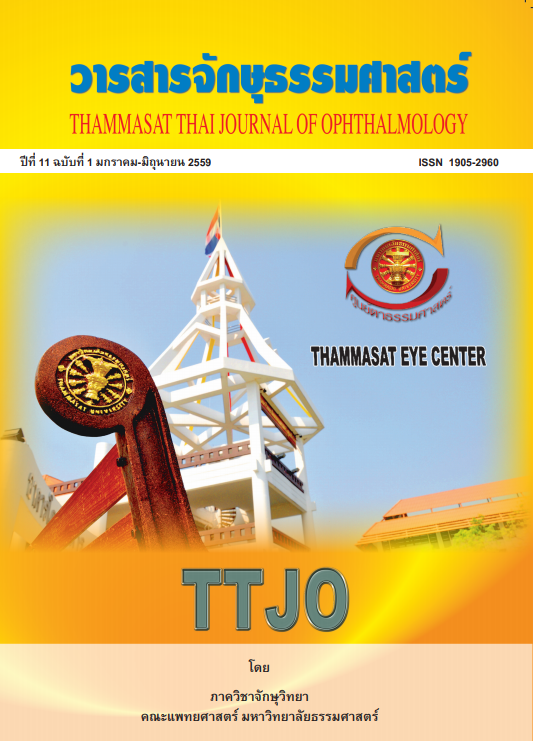การศึกษาภาวะแทรกซอนขณะทําการผาตัดตอกระจกโดยคลื่นเสียงอัลตราซาวด โดยแพทยประจําบานชั้นปที่ 3 ในโรงพยาบาลธรรมศาสตรเฉลิมพระเกยีรติ
Main Article Content
Abstract
บทคัดยอ
วัตถุประสงค: เพื่อศึกษาภาวะแทรกซอนที่เกิดขึ้นในระหวางการผาตัดตอกระจกดวยเครื่องสลายตอกระจก คลื่นอัลตราซาวด (phacoemulsification) ของแพทยประจําบานจักษุชั้นปที่ 3
รูปแบบการศึกษา: การศึกษาแบบเชิงพรรณนา (descriptive study)
วิธีการศึกษา: โดยเก็บขอมูลยอนหลัง (retrospective) จากแบบสอบถามที่ไดจากแพทยประจําบานชั้นปที่ 3 ที่บันทึกรายงานการผาตัดในสมุดปูมเรือสําหรับบันทึกเหตุการณ (logbook) ที่มีภาวะแทรกซอนระหวางการ ผาตัดดวยเครื่องสลายตอกระจกคลื่นอัลตราซาวด (phacoemulsification) ระหวางเดือนเมษายน พ.ศ. 2557 ถึงเดือนมีนาคม พ.ศ. 2558 ในโรงพยาบาลธรรมศาสตรเฉลิมพระเกียรติ
ผลการศึกษา: จํานวนผูปวยทั้งหมด 156 คน เกิดภาวะแทรกซอนระหวางการผาตัด 31 คน (19.87%) โดยเกิด ในขั้นตอน wound construction 1 คน (0.64%) ซึ่งเกิดแผลผาตัดรั่ว (wound leak), ขั้นตอน capsulorhexis and hydrodissection 21 คน (13.46%) โดยทั้งหมดเกิด radial tear ของ anterior capsule ในชวง capsulorhexis, ขั้นตอน nucleus removal 7 คน (4.48%) โดยในชวง cracking เกิด posterior capsule rupture with vitreous loss 2 คน (1.28%) และ posterior capsule rupture with drop nucleus 1 คน (0.64%), ในชวง emulsify nucleus เกิด posterior capsule rupture without vitreous loss 4 คน (2.56%), ขั้นตอน irrigation and aspiration of cortex 2 คน (1.28%) โดยในชวง cortex aspiration เกิด posterior capsule rupture without vitreous loss 1 คน (0.64%) และในชวง capsule polishing เกิด posterior capsule rupture without vitreous loss 1 คน (0.64%), ขั้นตอน insertion of IOL ไมพบภาวะแทรกซอน
สรุปผลการศึกษา: ภาวะแทรกซอนที่พบมากที่สุด คือ เกิด radial tear ของ anterior capsule ในขั้นตอน capsulorhexis and hydrodissection 21 คน คิดเปน 13.46% ภาวะแทรกซอนที่รุนแรง (major complications) เชน vitreous loss หรือ drop nucleus เกิดขึ้น 3 คนคิดเปน 1.92% โดยทั้งหมดเกิดขึ้น ในชวง cracking ของขั้นตอน nucleus removal จากงานวิจัยนี้พบวา การผาตัดตอกระจกโดยเครื่องสลายตอ กระจกดวยคลื่นอัลตราซาวดโดยแพทยประจําบานจักษุชั้นปที่ 3 สามารถทําไดโดยมีภาวะแทรกซอนนอย
Intraoperative complications in third-year resident performed phacoemulsification cataract surgery in Thammasat university hospital
Abstract
Purpose: To evaluate the complications related to cataract surgery using the phacoemulsification technique by third-year ophthalmology residents.
Design: Descriptive study Methods: This study is a retrospective description. The study included all patients who underwent phacoemulsification cataract surgery by third-year residents and had complications between April 2014 and March 2015 at Thammasat university hospital. The residents were given questionnaires to retrospectively report on complications.
Results: 31 of 156 surgical cases (19.87%) involved complications. The number of complications at each stage were the following; the wound construction stage resulted in 1 case of wound leakage (0.64%), the stage of capsulorhexis and hydrodissection resulted in radial tears of the anterior capsule in 21 cases (13.46%), the stage of nucleus removal in 7 cases (4.48%), the cracking stage resulted in posterior capsule rupture with vitreous loss in 2 cases (1.28%), posterior capsule rupture with dropped nucleus in 1 case (0.64%), emulsification of the nucleus resulted in posterior capsule rupture without vitreous loss in 4 cases (2.56%), the stage of irrigation and aspiration of cortex in 2 cases (1.28%), the cortex aspiration resulted in posterior capsule rupture without vitreous loss in 1 case (0.64%), and the capsule polishing stage resulted in posterior capsule rupture without vitreous loss in 1 case (0.64%). No complication was found during the stage of intraocular lens (IOL) insertion.
Conclusion: The most common intraoperative complications occurred during capsulorrhexis and hydrodissection, resulting in radial tears at the anterior capsule in 21 cases (13.46%). Major complications such as vitreous loss or dropped nucleus occurred in 1.92%, all of which occurred during the nucleus removal stage. The residents can perform phacoemulsification with low complication rates.
Article Details
References
Bourne RR, Stevens GA, White RA, Smith JL, Flaxman SR, Price H, et al. Causes of vision loss worldwide,1990-2010:a systematic analysis. Vision Loss Expert Group. Lancet Glob Health. 2013 Dec;1(6):339-49.
Bourne RR, Jonas JB, Flaxman SR, Keeffe J, Leasher J, Naidoo K, et al; Prevalence and causes of vision loss in high-income countries and in Eastern and Central Europe: 19902010. Vision Loss Expert Group of the Global Burden of Disease Study. Br J Ophthalmol. 2014 May;98(5):629-38.
Wong TY, Zheng Y, Jonas JB, Flaxman SR, Keeffe J, Leasher J, et al. Prevalence and causes of vision loss in East Asia: 1990-2010. Vision Loss Expert Group of the Global Burden of Disease Study. Br J Ophthalmol. 2014 May;98(5):599-604.
Leaming DV. Practice styles and preferences of ASCRS members 1996 survey. J cataract Refract Surg. 1997;17:527- 35.
Corey RP, Olson RJ. Surgical outcomes of cataract extractions performed by residents using phacoemulsification. J Cataract Refract Surg.1998 Jan;24(1):66-72.
Ng DT, Rowe NA, Francis IC, Kappagoda MB, Haylen MJ, Schumacher RS, et al. Intraoperative complications of 1000 phacoemulsification procedures: A prospective study. J Cataract Refract Surg. 1998 Oct;24(10):1390-95.
Bhagat N, Nissirios N, Potdevin L, Chung J, Lama P, Zarbin MA, et al. Complication in resident-performed phacoemulsification cataract surgery at New Jersey Medical School. Br J ophthalmol 2007;91:1315-17.
Tarbet KJ, Mamalis N, Theurer J, Jones BD, Olson RJ. Complications and results of phacoemulsification performed by residents. J Cataract Refract Surg.1995 Nov;21(6):66165.
Randleman JB, Wolfe JD, Woodward M, Lynn MJ, Cherwek DH, Srivastava SK. The resident surgeon phacoemulsification learning curve. Arch Ophthalmol. 2007 Sep;125(9):1215-19.
Prasad S. Phacoemulsification learning curve: experience of two junior trainee ophthalmologists. J Cataract Refract Surg. 1998 Jan; 24(1):73-7.
Martin KR, Burton RL. The phacoemulsification learning curve: per-operative complications in the first 3000 cases of an experienced surgeon. Eye 2000 ;14:190-95.
Zare M, Javadi MA, Einollahi B, Baradaran-Rafii AR, Feizi S, Kiavash V. Risk Factors for Posterior Capsule Rupture and Vitreous Loss during Phacoemulsification. J Ophthalmic Vis Res. 2009 Oct;4(4):208-12.
Hayashi K, Hayashi H, Nakao F, Hayashi F. Outcomes of surgery for posterior polar cataract. J Cataract Refract Surg. 2003 Jan;29(1):45-9.
Blomquist PH, Morales ME, Tong L, Ahn C. Risk factors for vitreous complications in resident-performed phacoemulsification surgery. J Cataract Refract Surg. 2012 Feb;38(2):208-14.


